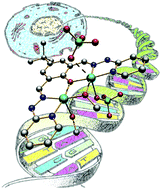Highly cytotoxic DNA-interacting copper(ii) coordination compounds†
Abstract
Four new Schiff-base ligands have been designed and prepared by condensation reaction between hydrazine derivatives (i.e. 2-hydrazinopyridine or 2-hydrazinoquinoline) and mono- or dialdehyde (3-tert-butyl-2-hydroxybenzaldehyde and 5-tert-butyl-2-hydroxyisophthalaldehyde, respectively). Six copper(II) coordination compounds of various nuclearities have been obtained from these ligands, which are formulated as [Cu(L1)Cl](CH3OH) (1), [Cu(L2)NO3] (2), [Cu2(L3)(ClO4)2(CH3O)(CH3OH)](CH3OH) (3), [Cu2(L4)(ClO4)(OH)(CH3OH)](ClO4) (4), [Cu8(L3)4(NO3)4(OH)5](NO3)3(CH3OH)5(H2O)8 (5) and [Cu3(HL2′)4Cl6](CH3OH)6 (6), as revealed by single-crystal X-ray studies. Their DNA-interacting abilities have been investigated using different characterization techniques, which suggest that the metal complexes act as efficient DNA binders. Moreover, cytotoxicity assays with several cancer cell lines show that some of them are very active, as evidenced by the sub-micromolar IC50 values achieved in some cases.


 Please wait while we load your content...
Please wait while we load your content...